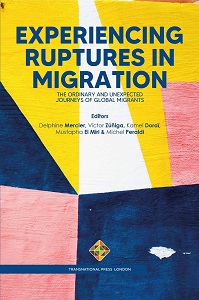Working in The Maquiladoras, Migrating To Survive and Living Transnationally
Working in The Maquiladoras, Migrating To Survive and Living Transnationally
Author(s): Delphine Mercier
Subject(s): Migration Studies
Published by: Transnational Press London
Keywords: Working; Maquiladoras; migrating; survive; living; transnationally; Mexico;
Summary/Abstract: Suzana was 47 years old when I met her. She comes from an Azumbilla village in the state of Puebla, Mexico. Her whole family is still there: her mother, her siblings, her husband, and two of her daughters. She left her village 10 years ago to go to work in Mexico City, the capital of Mexico, in the domestic work sector. Before arriving in Mexico, Suzana worked in the maquiladora textile factories1 of Azumbilla. These precarious factories assembled clothes (shorts, trousers, shirts, etc.) for the US army. The factories were set up near2 La Bestia railway line, La Bestia being the freight train that traverses the length of Mexico and transports illegal migrants from Central America or other regions of Mexico. The train passes by very close to Azumbilla. Migration in their village is part of the history of every family; everyone has an episode of migration to the United States in this village. Suzana married very young and had two daughters. Her first husband left her and moved in with the neighbour with whom he had eleven children. Following this traumatic moment in her life as a wife, woman and mother, Suzana decided to work in transnational companies, no doubt hoping to get closer to the United States. She then met someone else while she was still married to her first husband. Her fiancé left for the United States to earn money and to bring her there later. Suzana was pregnant and waited several months without any news. One morning her fiancé's mother told her that she should not waiting any longer, that he will not come back and that he has found another woman there. Suzana lived through her second trauma. She left to go to Mexico (internal migration) where she stayed at her cousins' house. Initially, her daughters stayed in Azumbilla with their grandmother. The eldest had already reached adulthood and joined her mother, and the two youngest stayed in Azumbilla. The second youngest married a local, Oscar who also migrated for two years to build up capital. The youngest daughter stayed in the village in the small house that Suzana managed to build little by little over time. Her youngest daughter was also in a relationship, much too young according to Suzana. Aged 17 years old, her boyfriend almost migrated on a whim while her daughter was expecting a baby. Suzana intervened; she found work for her third son-in-law in the textile maquiladora. Her eldest daughter married a local who found a job in Mexico City. He is a building caretaker; it is better than nothing. This situation highlights a trajectory of precariousness during which migration appears as a possible step, a possible job in the precarious “career”.
Book: Experiencing Ruptures in Migration. The Ordinary and Unexpected Journeys of Global Migrants
- Page Range: 147-159
- Page Count: 13
- Publication Year: 2021
- Language: English
- Content File-PDF

